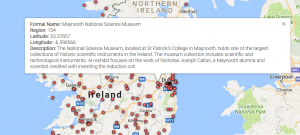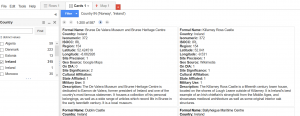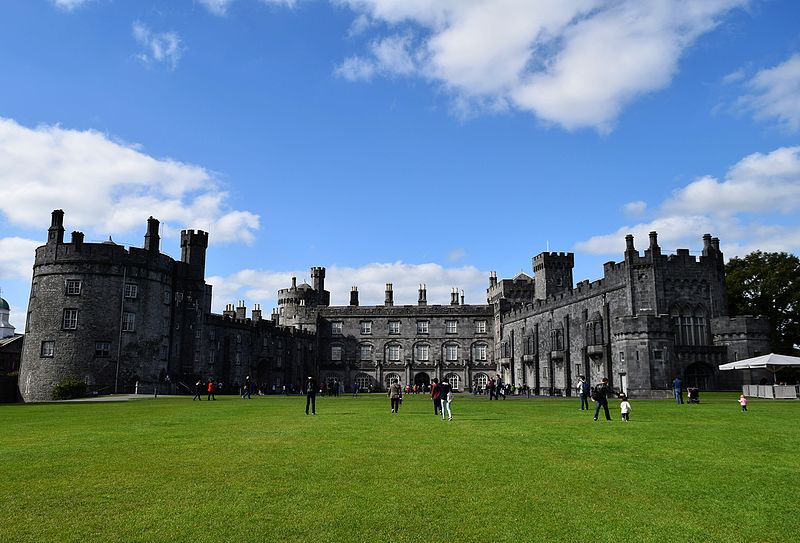My internship this summer with the Vanderbilt Center for Digital Humanities could not have been better. I had the opportunity to learn from Dr. Mickey Casad and other scholars and digital directors at Vanderbilt. They included Juliet Larkin-Gilmore, Dr. Angela Sutton, Dale Poulter, and Dr. Steven Wernke. I also had the chance to meet and collaborate with scholars from other institutions such as Dr. Chad Berry (Berea College), Dr. Reavis Mitchell (Fisk University), Dr. Lea Williams (Tennessee State University), Dr. Van West (Middle TN State University), Dr. Molly Taylor-Polesky (Middle TN State University), and Dr. Carole Bucy (Volunteer State College). Finally, I had many meeting with community stakeholders related to the Nashville Sites Digital Project including Nashville Public Library, Metro Archives, TN State Library and Archives, Slave Societies Digital Archive (Vanderbilt), Fog Haus, Metro Historical Commission, Belmont University, Middle TN State University, Convention and Visitors Corp., Smithsonian Institute, Humanities Tennessee, and more.
All of that to say, it has been a joyful internship. My experience has provided me with new digital skills (particularly after meeting with Dale Poulter last week about Fedora and Islandora), while also allowing me to flex my own (digital) muscles. Not only has Dr. Casad and the center supported my work with Nashville Sites, I will also have the chance to give back in two weeks–as I lead a workshop at the Vanderbilt DH Bootcamp. I will be teaching a session on Omeka to Vanderbilt faculty. In terms of Nashville Sites, I am happy to report that just yesterday, I passed off all metadata and tour narratives and maps for the first five tours. They are: Downtown School and Education, Food for Thought (restaurants either historic themselves or in historic buildings), Civic and Public Spaces, Architecture Highlights, and Nashville’s Seedy Side.
This summer I put much of the knowledge gained through George Mason University coursework into action. That is perhaps the best part. My coursework at GMU inspired my work with Nashville Sites, which in turn has allowed me to turn this class project into “a real thing,” and has also led to me learning many new things on my own and from others connected to the Vanderbilt Center for DH. I can’t thank Dr. Casad and Dr. Platt enough for their encouragement, guidance, and support.
A final word of thanks to George Mason for giving me the skills and experience to expand my professional portfolio. This past year, I led a Digital Humanities Initiative at Harpeth Hall, which resulted in my work with at least one teacher in every academic discipline (except math) to develop a digital project. My work in Digital Humanities also played a big role in my recent one-year appointment as Professor of Practice at Belmont University next year. Dr. Mimi Barnard’s vision and ingenuity made this appointment possible. I will be teaching an intro to Digital Humanities course as well as work with students on Nashville Sites (also two additional courses). In sum, Belmont is hosting me as I teach and work on this project. Two years ago, I could not have imagined that this certificate program would lead to a new position.
Below, I will share part of one of the completed tours as a sample. I will not send metadata as it is still being edited, and the GIS is under construction. I look forward to sharing the actual site when it is launched (estimated date August 2019). There should be approximately twenty tours. Enjoy.
1. The Hermitage Hotel/Capitol Grille/Oak Bar
J. Edwin Carpenter’s 1910 Hermitage Hotel is designed in the Beaux Arts Style, and even if you choose not to eat here, a visit inside is worth your time. Along with the ornate lobby and restaurant, the Art Deco men’s restroom located near the Oak Bar is famous for its design. Ladies, you can check out the restroom as well, just ask the hotel staff.
In the months before Tennessee’s decision to ratify the Nineteenth Amendment (August 18, 1920), both proponents and opponents of woman’s suffrage established headquarters at the Hermitage Hotel. They chose the location for its proximity to the capitol building, where women could not hold office but could lobby for their causes. After a fierce political battle, Tennessee became the thirty– sixth state to ratify the amendment, which met the 2/3rd state threshold needed, granting women the constitutional right to vote. Tennessee is still called the “Perfect 36” for its role in the ratification process.
The Capitol Grille, originally called the Grill Room, once served clear green turtle soup, Tennessee squab, celery, and salted almonds. While these dishes epitomized fine dining in the early twentieth century, they no longer exist regularly on the menu. Even though food tastes change over time, Capitol Grille has continued its long-standing tradition of using locally sourced ingredients when possible. The hotel owns Double H Farms that raises free range cattle and uses seasonal vegetables grown at historic Glen Leven Farm. If you don’t want a full meal, unwind in the Oak Bar, originally an exclusive men’s club. Today all can enjoy this space, which has served drinks and dinner for over a century.
Move southeast on Sixth Ave. toward Church St, and turn LEFT onto Church St. Then, turn LEFT onto Fifth Ave N to reach 227 Fifth Ave. North. Woolworth on 5th is about halfway up the block. Along the way, you will pass buildings with historical, architectural, and artistic significance. On Sixth Ave. North, take note of the Herakut mural of the dog, created through the Nashville Walls Project. Church Street is full of important sites including the Nashville Public Library, 505 Nashville, and the Downtown Presbyterian Church, which you pass on your right as you walk toward Fifth Avenue.
Additional Info: Hermitage Hotel Audio
2. Woolworth on 5th
In February 1960, a group of black students from Fisk University, Tennessee A&I (now Tennessee State University), and American Baptist College boldly sat down at the lunch counters of Woolworth’s, Kress, and McClellan—all department stores. This is how Nashville’s sit-in movement began. Implementing methods of non-violent protest, young Civil Rights leaders such as John Lewis, James Lawson, and Diane Nash began a historic journey to end racial segregation. In the face of violence, intimidation, and arrest—the determined spirit and perseverance of these and other students led Mayor Ben West to support desegregation. He did so, and the Nashville business community followed by integrating lunch counters, stores, and restaurants. By the summer of 1960, Nashville had desegregated all public facilities—the first southern city to do so.
After a major renovation, the Woolworth building reopened as a restaurant in early 2018. The venue hosts a “welcome table for all,” showcasing the Civil Rights movement in Nashville through historic photographs and visibly patched floors where the segregated lunch counters were removed. Visitors can enjoy live jazz, R&B, early rock, and more while dining.
Woolworth’s reflects the power of food to connect the past to the present and to provide a window into the complicated nature of southern culture and identity. You can likely think of popular foods associated with the American southeast: barbecue, fried chicken, or biscuits. These dishes represent points of contact between Native Americans, African Americans, and European Americans. These popular dishes reveal stories about women and men, many enslaved, who cooked for others and adapted foods during times of plenty and times of need. As you explore Woolworth on 5th, consider how its “welcome table for all” unites not only those who challenged Jim Crow with the present, but also celebrates the different races, classes, and cultures who made the cuisine we know and love today.
Turn LEFT outside of Woolworth on 5th; after walking about thirty yards, turn RIGHT at the Fifth Ave. North crosswalk to reach The Arcade located across the street. When you leave Woolworth’s you will see a historical marker describing the sit-ins.
Audio about Civil Rights Movement sit-ins in Nashville, TN
- Oral History Interview with Edward F. Jones, 2006 November 3, excerpt 17, is a three minute clip of Jones describing the sit-in movement in broad terms. He mentions student activism, and the negotiations between business owners and student activist leaders.
- Citation per NPL: Edward F. Jones, Series 1, The Turner Interviews, Nashville Business Leaders Oral History Project, Special Collections Division, Nashville Public Library.
3. The Arcade (and Peanut Shop)
If you seek a variety of options and a quick meal, drink, or snack—Nashville’s Arcade, located across the street from Woolworth on 5th, is the place for you. For decades, Nashvillians saw Fifth Avenue as the most popular shopping area in the city. At its peak in the early twentieth century, department stores lined the street, and the Arcade was the center of it all.
Running though the middle of the block between Fourth and Fifth Avenues, this space was originally a rose garden called Overton Alley. In 1903, Daniel C. Buntin funded the construction of a two-story indoor shopping venue designed by the architectural firm Thompson, Gibel and Asmus. Modeled after the famous Galleria Vittorio Emmanuele in Milan (Italy), the Arcade features a glass-gabled roof, reinforced with steel beams made in East Nashville. When the city celebrated the Arcade’s opening, approximately 40,000 people gathered for shopping, music, and mingling. Shop owners and businesses in Nashville’s Arcade have changed over time, and the second floor mezzanine currently boasts art galleries that participate in the free Downtown Nashville First Saturday Art Crawl.
The street level promenade offers over twenty food stops with pizza, deli sandwiches, tacos, Chinese food, coffee, pastries, and more. The plethora of affordable options allows customers to find the perfect meal while taking in the architecture of this hidden gem. The oldest store in the building, The Peanut Shop, opened in 1927. Owned by Planters Peanuts until 1960, the store has run independently for over fifty years. Much of the decoration here is original, so make sure you look around if you stop in for a treat.
After walking STRAIGHT through the Arcade, you arrive on Fourth Ave. North and see the Bobby Hotel directly across the street. Turn RIGHT and you will see a crosswalk which you will take to get to the other side of the street. The small road in front of you that separates the Bobby Hotel from the Southern Turf building is called Metro Alley. The Southern Turf building, the historic location of your next stop, is on your RIGHT. Take the alley to Skull’s Rainbow Room restaurant and bar, located in the back of the Southern Turf building.



















